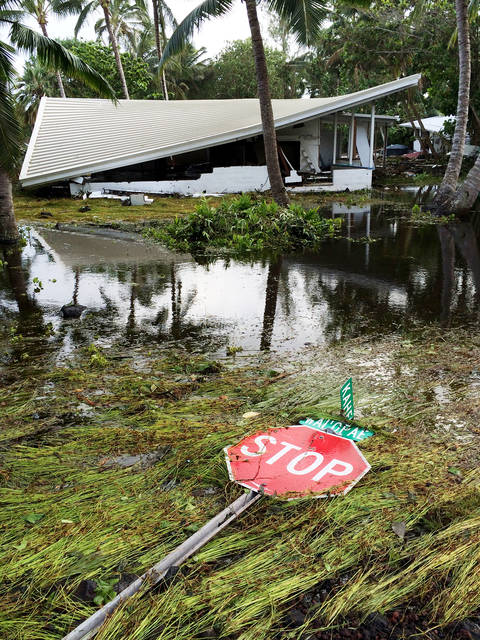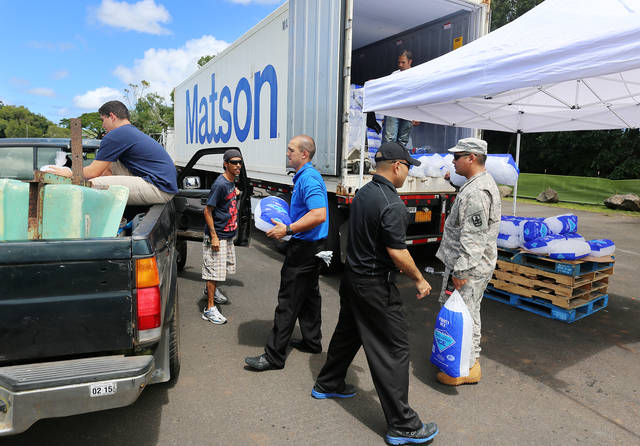KAILUA-KONA — More than 25 years ago, Valerie Delahaye-Ippolito stepped outside the Citadel in Cairo, Egypt, when an earthquake hit, toppling a building to the ground in front of her eyes.
It was an eye-opening experience for the woman, who said it immediately taught her the value of being ready for any disaster and the importance of having a plan in place long before it’s ever needed in a crunch.
“I realized that it doesn’t matter where you are in the world, things happen,” she said. “And knowing how to act properly is huge. And it can save lives.”
It’s a point Delahaye-Ippolito, who runs staging company Mahalo Hale and is also certified as part of CERT — Community Emergency Response Team, emphasized at a community talkstory on disaster preparedness held Saturday at Keauhou Shopping Center.
The event was planned as the first in a series to get people prepared for any kind of disaster as well as how to react in the wake of an emergency.
“Our real goal is to bring information — usable, relevant, valuable information — to the community to educate and empower people to be leaders in their community,” Minoo Elison, principal broker and owner of Connect Hawaii Real Estate Services.
And a big point for the day’s workshop was to offer community members tools and resources they can take home with them and start right away.
Hawaii is about a month and a half into the hurricane season, which runs June 1 through Nov. 30. The National Oceanic and Atmospheric Administration’s Central Pacific Hurricane Center in May indicated a strong likelihood of “near- or above-normal tropical cyclone activity” this season.
Throughout the season, the hurricane center predicted three to six tropical cyclones in the Central Pacific hurricane basin, including tropical depressions, named storms and hurricanes.
It’s not just natural disasters that were on people’s mind Saturday. January’s false missile alert came up as another example of the need to be prepared to act immediately.
Paul Morgan, a State Farm insurance agent, shared how he was able to react immediately to the missile alert before word came out that it was a false alarm, but noted that he could respond quickly because he had a plan in place.
“So have a contingency plan and make sure it works,” he said, emphasizing the need to not only have a plan but practice it as well.
Because preparing for a disaster — natural or otherwise — is preparing for the inevitable, said Delahaye-Ippolito.
“It’s not ‘maybe,’” she said. “It will happen.”
And a crucial element of that preparedness, Delahaye-Ippolito said, is the “family folder,” a thorough series of checklists covering everything from the names and dates of birth of every family members to medical and insurance information as well as vital paperwork. It’s also important to make three hard copies of those lists, she said: one to be sent out of state, one to go to a neighbor and a third that stays by the front door.
Delahaye-Ippolito’s advice also touched on elements of preparedness that might be less obvious, including having a wrecking bar to pry open doors as well as a pair of durable boots for everyone in the family in the event of a quick evacuation.
“And that should be tucked under your bed,” she said, “because the minute there’s an earthquake, there is glass everywhere. The biggest problem during earthquakes is laceration of people’s feet, because they run out of bed and cut themselves to shred.”
Morgan meanwhile offered his expertise on insurance and the importance of being aware of what sort of policy and coverage a person has, staying on top of that policy and coverage as a person’s situation changes and what that means in the wake of an emergency. That includes coverages specifically for disasters like floods, earthquakes and hurricanes, which might not necessarily be covered under a standard homeowner or rental policy.
Morgan recommended people review their policies and coverage when there are any life changes, such as marriage or divorce, and at least annually.
The date for the next talkstory session hasn’t been announced, but Delahaye-Ippolito said they would like to have the meetings monthly.
“Our concept here is to start with a little pebble and have a huge ball rolling by the time we are done,” she said, “where we can help our community in case of disaster.”
And having that knowledge and ability to respond, she said after the event, means not having to think on your feet in a life-or-death situation.
“You don’t have to come up with a plan,” she said. “It’s already in place.”






